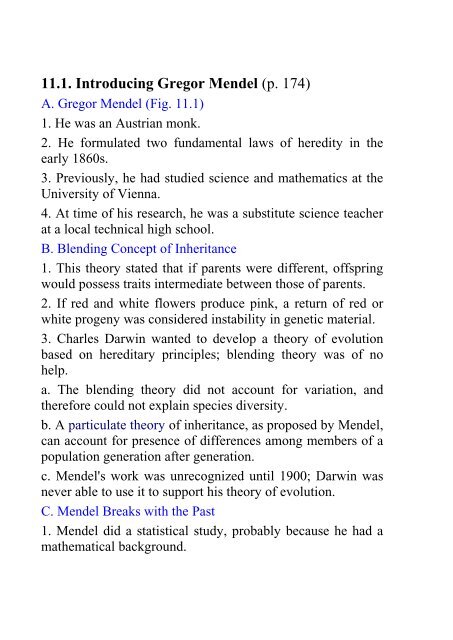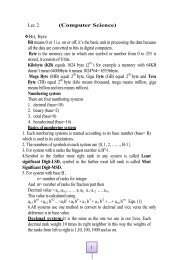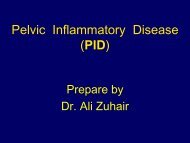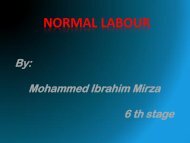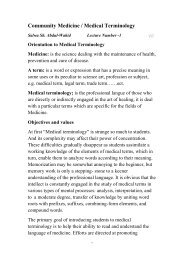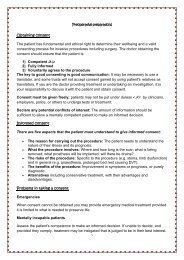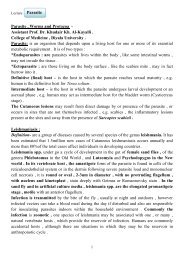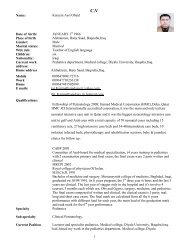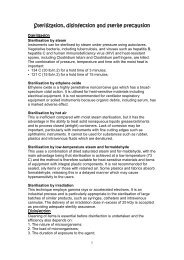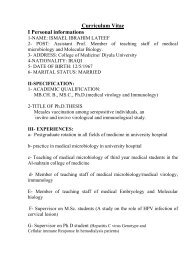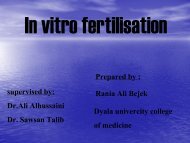11.1. Introducing Gregor Mendel (p. 174)
11.1. Introducing Gregor Mendel (p. 174)
11.1. Introducing Gregor Mendel (p. 174)
Create successful ePaper yourself
Turn your PDF publications into a flip-book with our unique Google optimized e-Paper software.
. F 1 generation is the first-generation offspring in a breedingexperiment.c. F 2 generation is the second-generation offspring in abreeding experiment.B. <strong>Mendel</strong>'s Results1. Contrary to those predicted by a blending theory ofinheritance.2. He found that the F 1 plants resembled only one of theparents. (Fig. 11.3)3. Characteristic of other parent reappeared in about 1/4 of F 2plants; 3/4 of offspring resembled the F 1 plants. (Fig. 11.34. <strong>Mendel</strong> saw that these 3:1 results were possible ifa. F 1 hybrids contained two factors for each trait, onedominant and one recessive;b. factors separated when gametes were formed; a gametecarried one copy of each factor;c. random fusion of all possible gametes occurred uponfertilization.5. Results of his experiments led <strong>Mendel</strong> to develop his firstlaw of inheritance:a. <strong>Mendel</strong>'s law of segregation: Organism contains twofactors for each trait; factors segregate in formation ofgametes; each gamete contains one factor for each trait.b. <strong>Mendel</strong>'s law of segregation is consistent with a particulatetheory of inheritance because many individual factors arepassed on from generation to generation.c. Recombination of factors explains variations and whyoffspring differ from their parents.
C. Modern Genetics Has an Explanation1. Each trait in a pea plant is controlled by two alleles,alternative forms of a gene that occur at the same gene locuson homologous chromosomes.a. Dominant allele masks or hides expression of a recessiveallele; it is represented by an uppercase letter. (e.g., T in Fig.11.4)b. Recessive allele is an allele that exerts its effect only in thehomozygous state; its expression is masked by a dominantallele; it is represented by a lowercase letter. (e.g., t in Fig.11.4)2. Gene locus is specific location of a particular gene onhomologous chromosomes. (Fig. 11.4)3. In <strong>Mendel</strong>'s cross, the parents were true-breeding; eachparent had two identical alleles for a trait--they werehomozygous, indicating they possess two identical alleles fora trait.a. Homozygous dominant genotypes possess two dominantalleles for a trait.b. Homozygous recessive genotypes possess two recessivealleles for a trait.4. After cross-pollination, all individuals of the F 1 generationhad one of each type of allele.a. Heterozygous genotypes possess one of each allele for aparticular trait.b. The allele not expressed in a heterozygote is a recessiveallele.5. Two organisms with different allele combinations can havesame outward appearance (e.g., TT and Tt pea plants are both
second child born still has 1/4 chance of having attachedearlobes.G. <strong>Mendel</strong> Did a Testcross (Fig. 11.6 )1. <strong>Mendel</strong> performed testcrosses by crossing his F 1 plantswith homozygous recessive plants.2. Results indicated the recessive factor was present in the F 1plants; they were heterozygous.3. A testcross is between an individual with dominantphenotype and individual with recessive phenotype to see ifthe individual with dominant phenotype is homozygous orheterozygous.11.3. <strong>Mendel</strong> Did a Dihybrid Cross (page 181)A. Dihybrid Crosses. (Fig. 11.7)1. A dihybrid cross is an experimental cross between twoparent organisms that are true-breeding for different forms oftwo traits; produces offspring heterozygous for both traits.(TTGG x ttgg ) TtGg2. <strong>Mendel</strong> observed that the F 1 individuals were dominant inboth traitsB. Plants to Self-Pollinate.1. <strong>Mendel</strong> observed four phenotypes among F 2 offspring; hededuced second law of heredity.2. <strong>Mendel</strong>'s law of independent assortment states membersof one pair of factors assort independently of members ofanother pair; all combinations of factors occur in gametes.
C. Doing Dihybrid Genetics Problems1. Laws of probability indicate a 9:3:3:1 phenotypic ratio ofF 2 offspring resulting in the following:a. 9/16 of the offspring are dominant for both traits;b. 3/16 of the offspring are dominant for one trait andrecessive for the other trait;c. 3/16 of the offspring are dominant and recessive oppositeof the previous proportions; andd. 1/16 of the offspring are recessive for both traits.2. Punnett square for dihybrid crossesa. A larger Punnett square is used to calculate probable resultsof a dihybrid cross. (Fig. 11.8)b. A phenotypic ratio of 9:3:3:1 is expected whenheterozygotes for two traits are crossed and simple dominanceis present for both genes.c. Meiosis explains these results of independent assortment.D. Dihybrids Can Be Tested Also1. Dihybrid testcrosses test if individuals showing twodominant characteristics are homozygous for both or for onetrait only, or is heterozygous for both. (Fig. 11.9)2. If an organism heterozygous for two traits is crossed withanother recessive for both traits, expected phenotypic ratio is1:1:1:1. (Fig. 11.9)
Q: what are the Significance of MeiosisSignificance of MeiosisA. Meiosis produces genetic variation.1. Without meiosis, chromosome numbers would continuallyincrease.2. Meiosis ensures daughter cells receive one of each kind ofgene; precisely halves the chromosome number.3. Independent assortment provides 2 n possible combinations ofchromosomes in daughter cells.4. In humans with 23 haploid chromosomes, 2 n = 2 23 =8,388,608 possible combinations.5. Variation is added by crossing-over; if only one crossoveroccurs within each bivalent, 4 23 or 70,368,744,000,000combinations are possible.6. Fertilization also contributes to genetic variation; (2 23 ) 2 =70,368,744,000,000 possible combinations without crossingover.
7. With fertilization and crossing-over, (4 23 ) 2 =4,951,760,200,000,000,000,000,000,000 combinations arepossible.B. Advantages of Meiosis1. Tremendous storehouse of genetic variation provides foradaptations to changing environment.2. Asexual organisms depend primarily on mutations togenerate variation.Q : Using <strong>Mendel</strong>'s monohybrid crossas an example, trace his reasoning toarrive at the law of segregation


